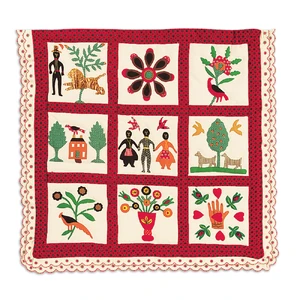All of American Girl's dolls in the Pleasant Company days got a bedtime collection released. This included a bed, bedtime accessories and a nightgown of course. Addy's bedtime collection was only one out of 5 to have the bedding available separately
1.1 until it was included with the bed in 2011
1.2 . The item I am talking about? Oh, yes, Addy's Family Album Quilt
1.3. It is a simulated quilt that had red trim (later changed to blue with the revamp of BeForever
1.4) and it mimics a
real quilt
2. From the name of the quilt alone, it can be presumed that this quilt is meant to tell a story about Addy's family and I have heard of story quilts in which each female family member, once they learn to sew, adds their own square to the fabric, adding to the story and creating a beautiful family heirloom.
 |
| Addy's Family Album Quilt [1.3] |
 |
| The real-life quilt it is based on [2] |
| Quilting is an American institution, right? No - the first documented quilted item was a garment shown on an ivory carving of an ancient Egyptian pharaoh 3. A quilted floor covering was found in Mongolia and has been dated back to sometime between the 1st and 2nd centuries BC 3. Europeans brought quilting back to Europe from the Middle East in the 11th century 3. From Europe, it came to America where it gained in popularity to make quilts as a pastime 3. As African slaves were brought to America, they too were introduced to quilting 2. Several groups of people from Central and West Africa had their own traditions regarding fabric and patterns 2. They were usually made to be put into clothes because - gasp - not all native Africans ran around in loincloths acting like savages! |
African textiles began their history in Ancient Egypt, where flax was harvested and woven into linen
4. Bologan or 'mud cloth' was hand woven by the Mali empire
4. It was actually dyed with a special kind of mud, thus the name
5. People of Cameroon would take the bark from trees, like the obom and raffia, and use it to make their own special textiles
4. Kings would be dressed in only the finest woven garments with even beads woven in. I mention these fabrics in particular because among the peoples to influence African American quilting were people who come from modern: Guinea, Mali, Senegal, Burkino Faso, the Republic of Benin, Nigeria, Cameroons, Zaire and Angola
2.
 |
| Mud Cloth [5] |
The tradition of weaving left a strong impact on African American quilting
2. Strips that were once woven into a textile were soon revolutionized for use in fabric quilting
2.
Now that the history lesson is over (for the most part), let's dive into making your very own Family Album Quilt for your dolls! Now, to achieve the African American aesthetic, if you want, there are many ways to do that, through asymmetry, strong colors and shapes, improvisation, multiple patterning and last but not
least storytelling 2.
To make a realistic quilt, you will need 3 layers - a decorated top, middle of cotton batting and a bottom. For a doll-sized quilt that can fit two dolls comfortably, you will need 12 inches of fabric for each layer. For patterns, you can do *anything* you want. Diamonds and circles are popular in African American quilting because they represent the cycle of life 2. Here is a scan of a couple of pages from a folk art book called 'The Book of Arts & Craft' by Marguerite Ickis & Reba Selden Esh - two with some patterns and another telling you how to sew step-by-step.
My mom and I are going to make our own family quilt. We've come up with our design, I'm just waiting for her to finish making something for a family friend then we'll start on it! I will update the blog with pictures and step-by-steps when we get around to it. There are
many resources both in print and on the web to help you out with this.
Sources
- http://americangirl.wikia.com/wiki/
- http://americangirl.wikia.com/wiki/Historical_Bedding
- http://americangirl.wikia.com/wiki/Rope_Bed
- http://americangirl.wikia.com/wiki/Family_Album_Quilt
- http://xroads.virginia.edu/~ug97/quilt/atrads.html
- https://www.emporia.edu/cgps/tales/quilte~1.html
- https://afrolegends.com/2013/05/17/history-of-african-fabrics-and-textiles/
- http://www.designsponge.com/2014/07/past-present-behind-mud-cloth.html





Comments
Post a Comment